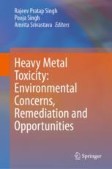Search
Search Results
-
Crop Responses to Metal Toxicity
Sustainable crop production is the key to global food security. With progress in industrialization, threats of pollution have increased, and one of...
-
Guidelines on Developmental Toxicity Tests: Brief Insights
Developmental toxicology is a constantly evolving research field which needs to attend to a complex underlying regulatory network. In order to ensure...
-
Molecular Toxicity Mechanism of Microplastics in the Reservoir
Recently, the toxicity of microplastics (MPs) has attracted global public health concerns. In this chapter, we reviewed the published studies on MPs...
-
Ecotoxicology Methodology of Sediment Toxicity in the Reservoir
The reservoir sediment can act as a drain and contaminant source. Once contaminants are released into the water column, they can be toxic for biota....
-
Toxicity Studies of Exosomes and Potential Overcome Approaches
Exosomes are nanosized, tiny extracellular particles that are produced by cells. They include varying quantities of protein, mRNA, miRNA, DNA, and...
-
Silicon Mitigates the Effects of Aluminium Toxicity
The mitigation of aluminium (Al) toxicity by silicon (Si) has now been studied for 60 years and is a well-established area of research, and we will...
-
Nanoparticles-Based Management of Cadmium Toxicity in Crop Plants
Cadmium is an important soil pollutant and poses serious challenges to crop production due to its significant toxicity to crop plants. However, crop...
-
Cadmium toxicity and autophagy: a review
Cadmium (Cd) is an important environmental pollutant that poses a threat to human health and represents a critical component of air pollutants, food...

-
Micronutrient Toxicity and Deficiency
Micronutrients are essential for plant growth although required in only very small amounts. There are eight micronutrients needed for healthy growth...
-
Mitochondrial dysfunction is underlying fluoroquinolone toxicity: an integrated mitochondrial toxicity assessment
BackgroundAntibiotics bear an inherent risk of mitochondrial toxicity due to the structural similarities between mitochondria and bacteria....

-
Human Pluripotent Stem Cell-Based Assays to Predict Developmental Toxicity
Human beings are continuously exposed to various toxic substances throughout their lives, which affect their reproductive health and eventually the...
-
Detection of Cyanotoxin Toxicity in Fish
Cyanobacteria can bloom under the right circumstances, a process marked by the increase of algal biomass and the potential production of cyanotoxins...
-
Molecular Toxicity Mechanism of PPCPs in the Reservoir
Due to the ubiquitous environmental occurrence and associated health risks, pharmaceuticals and personal care products (PPCPs) as emerging...
-
Physiological and molecular bases of the nickel toxicity responses in tomato
Nickel (Ni), a component of urease, is a micronutrient essential for plant growth and development, but excess Ni is toxic to plants. Tomato ( Solanum...

-
Probiotics for the Abrogation Arsenic Toxicity: A review
Arsenic toxicity, principally by polluted groundwater, is regarded as a momentous global public health risk, as there is no particular and proven...
-
Modeling drug-induced mitochondrial toxicity with human primary cardiomyocytes
Mitochondrial toxicity induced by therapeutic drugs is a major contributor for cardiotoxicity, posing a serious threat to pharmaceutical industries...
-
Strategies for alleviating aluminum toxicity in soils and plants
BackgroundAluminum (Al) toxicity poses a significant environmental stress factor, adversely affecting seed germination, crop establishment, quality,...

-
Cadmium Toxicity in Plants: Uptake, Translocation and Phytoremediation Strategy
Cadmium (Cd) is a highly noxious, unnecessary and heavy metal element with no known biotic purpose. Cd harms not only plants but also humans by...
-
Review of Zinc Oxide Nanoparticles: Toxicokinetics, Tissue Distribution for Various Exposure Routes, Toxicological Effects, Toxicity Mechanism in Mammals, and an Approach for Toxicity Reduction
Zinc oxide (ZnO) nanoparticles (NPs) are widely used as a sunscreen, antibacterial agent, dietary supplement, food additive, and semiconductor...

-
Flavones provide resistance to DUX4-induced toxicity via an mTor-independent mechanism
Facioscapulohumeral muscular dystrophy (FSHD) is among the most common of the muscular dystrophies, affecting nearly 1 in 8000 individuals, and is a...

